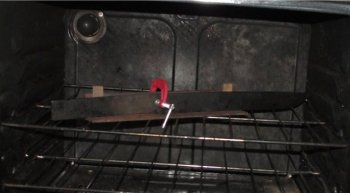Eddie Mullins
Well-Known Member
Just thought I'd share my method for correcting warp post quench. I have done this before and am currently doing so on my longest knife to date, a forged 5160, 1/4" thick, 1 1/2" wide, 15 1/2" blade. After the first 2 hour temper cycle I start applying 3 point pressure to correct through additional temper cycles. I do this using a piece of angle iron, a small c clamp and a couple of shims and putting the clamped blade back in the oven. I may be being too conservative but I do not try to correct all at once. After additional cycles I release the pressure , check for straightness and then adjust and repeat, using shims you can over bend if needed, but I do so gradually. I know there are other methods but this has worked for me and thought it might help some one else.


